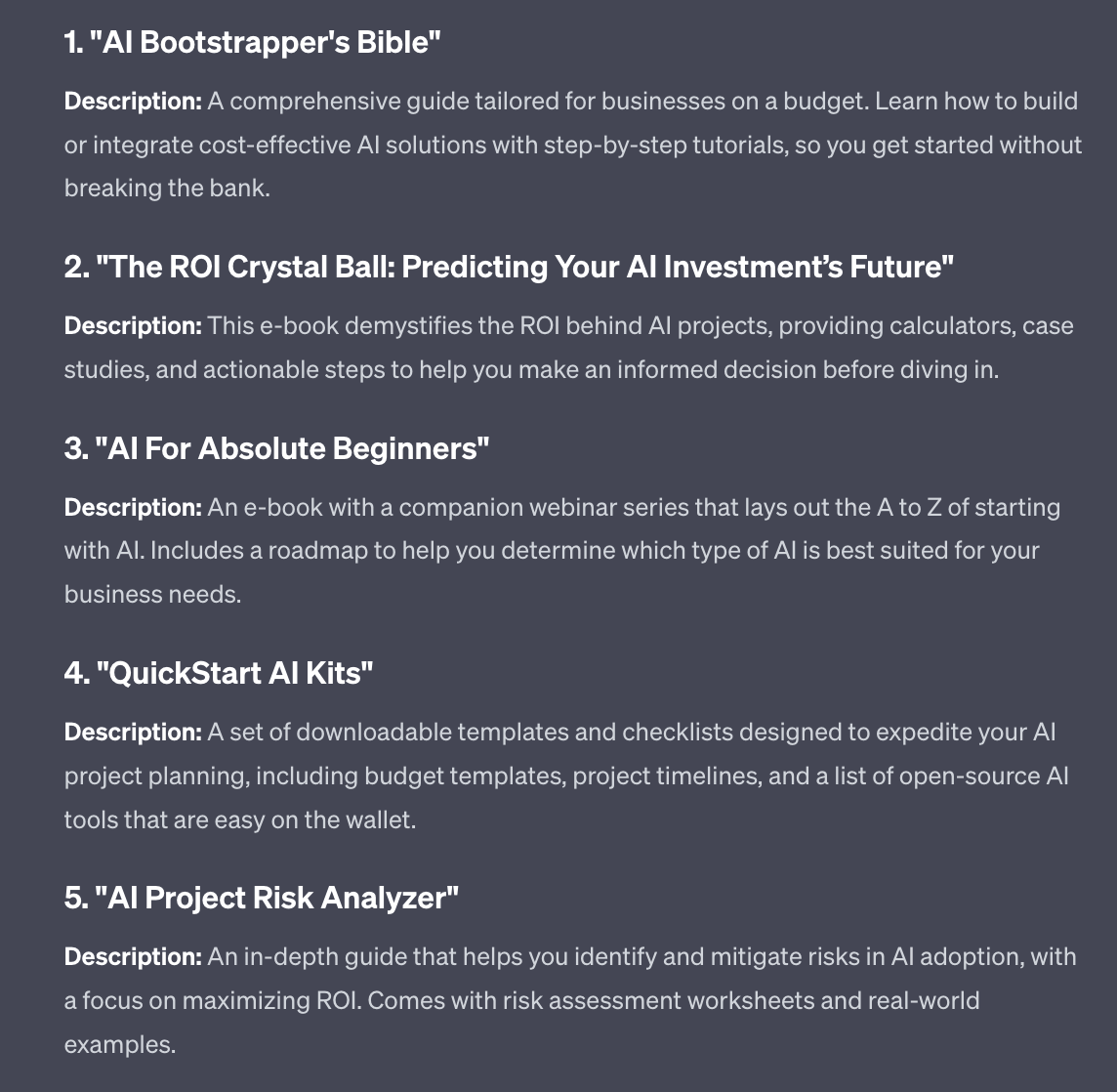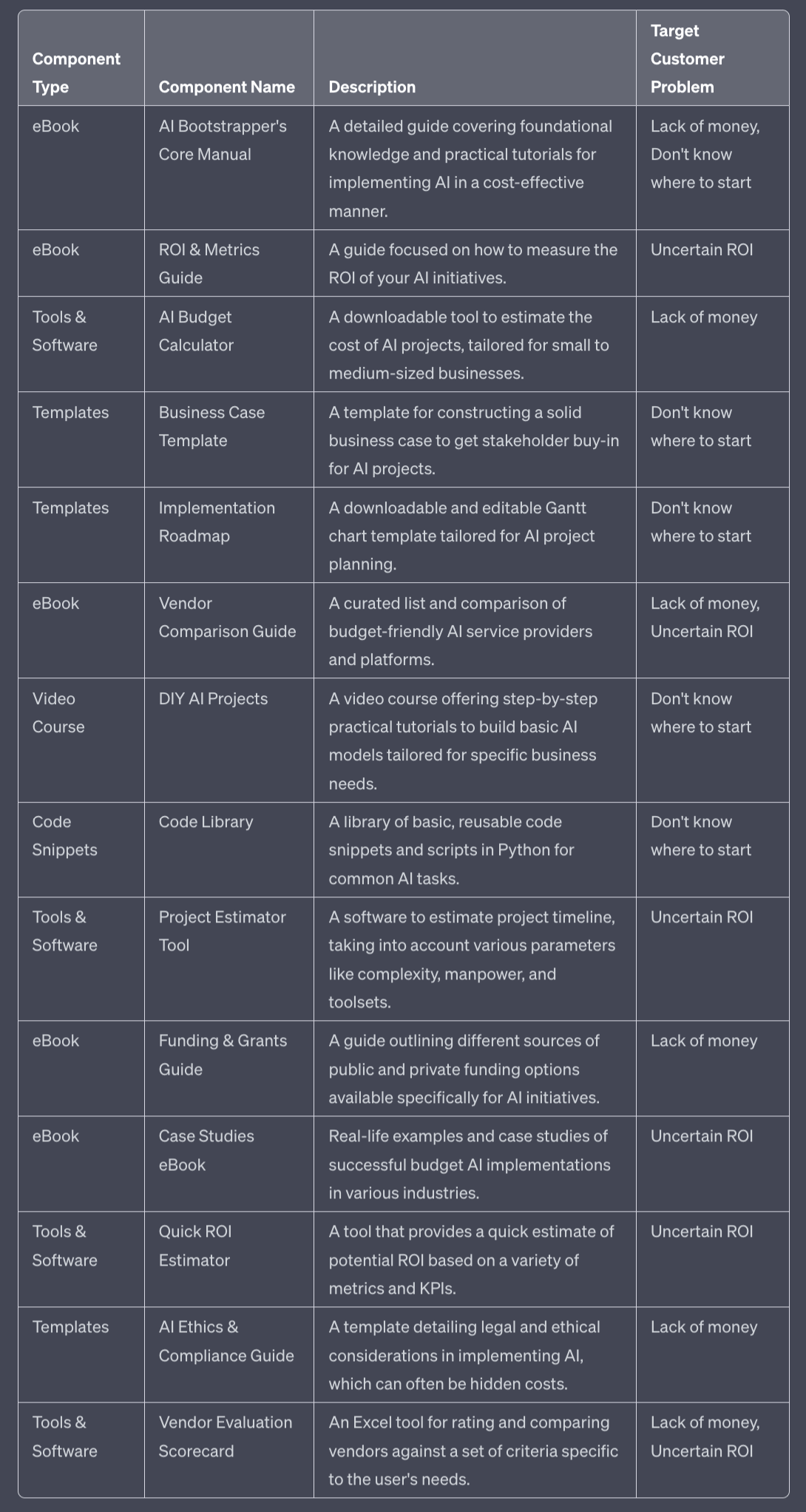Hey Prompt Entrepreneur,
This week we’ll be covering digital products : how to plan, build and market products that you can sell online.
This one is near to my heart as my first proper online business was digital products.
Digital products are fantastic because once you’ve created them they continue to sell on autopilot. It’s the closest we get to “passive income”.
It’s a great feeling to wake up in the morning with phone notifications telling you of new sales.
Don’t let that fool you though – there’s still work required to plan, create and market the product.
Thankfully thought you now have this guide to walk you through building digital products that will sell on autopilot.
The week will consist of these Parts:
Part 1: Plan your digital product
Part 2: Build your digital product
Part 3: Set up shop
Part 4: Market your digital product
Part 5: Expanding your product range
Let’s get started:
Plan your digital product
1. Solve a problem
We’re starting right at the beginning. We need our product to solve a problem – it’s a vital first step that many people miss.
Instead they just build something they think is cool and hope for the best.
Instead we need to find out what problems our customers actually have and then construct products to solve these problems.
Doing so will make our lives a lot easier, even if it requires more upfront work now.
If you want a masterclass on working out and refining an offer I’d recommend checking out Alex Hormozi’s $100M Offers.
I’ve also created a set of ChatGPT prompts to help guide you through the process -those are available here.
Feel free to supplement the work we do in this Part with the $100M framework for even stronger results.
How do we work out what problems we need to solve?
We ask.
We have to ask our audience and gauge their reactions. To do this we need an audience – there are other Prompt Playbooks that talk about how to build an audience using X/Twitter, LinkedIn and a newsletter. If you’ve followed those you already have an audience.
If not I’d recommend following the steps below and then boosting/advertising the post. For instance on X/Twitter you can post and then click Promote and pay to make it appear in front of potential customers. This will get you the same result – it just requires some advertising budget.
When asking potential customers we don’t want to be too broad.
If we just say “what are your biggest problems” we won’t get answers. People won’t take the time to answer this question as it requires too much time for them.
Instead we need to be more specific and offer examples to help them answer.
Here’s the prompt:
Act as a market research expert.
Generate a set of questions to elicit a potential customer's biggest problems. These problems will be solved by my product.
The product serves the [topic] niche.
Give me 10 questions, each with 4 alternative answers, that I can use in polls to elicit their true problems.
I used “AI in business” as my niche topic.
Prompt Output 💬

These are 2 out of the 10 questions generated. ChatGPT will create lots of questions about different areas of your topic area.
The goal now is to use these on X/Twitter, LinkedIn or your social platform of choice as polls. Polls are particularly popular on LinkedIn which is great news if your audience is there. If not the other social platforms have similar ways to survey your audience.
Continuously and frequently survey your audience to start to hone in on their problem areas. If you see certain answers don’t come up much you can start to ignore these in future questions.
Continue to do this until you’ve begun to hone in on their actual problems. Start collecting these problem areas together in a document.
For example over time I might find that the following problems come up again and again in my niche: lack of money, not knowing where to start and unclear ROI (return on investment).
Keep note as we’ll be using these problems in the next step.
2. Product Ideas
Let’s form these problem areas into product ideas. Remember that the products we build will solve problems for our customers.
We start with the title and description, which will be the first hook for potential customers.
Here’s the prompt:
Act as an expert product designer.
I am creating a digital product in the [topic] niche.
My customers' primary problems are [list problems]
Design 10 product ideas that solve some or all of these products.
The products should be writing based.
For each give me a catchy hook title and a short description. I used the “AI in business” niche and “lack of money, don’t know where to start, uncertain ROI” as problem areas.
Prompt Output 💬

ChatGPT will generate some potential product ideas all in your niche and focusing on the problem areas you highlighted.
How do you choose which idea to go with? Easy!
Take the options back to your audience and ask! Put 3-4 options in a poll and ask which of these your audience would like to see. Then go with the ones that score the best.
3. Product Contents
We now want to flesh out the contents of our chosen product idea.
We want to work out the “perfect” version of our product. The version that will solve all our customer’s problems.
Act as a product designer.
Generate a comprehensive product package for [product name, product description]
The topic area is [niche]
The customers' main problems are [problems]
Create an exhaustive list of product components in a tabular format.
Include only products, not services. Include only
digital products.Again add in your niche and customer problems.
Also copy paste in the product name and description you’ve chosen from the previously generated output.
Prompt Output 💬

ChatGPT will generate a long list of potential ways to tackle your customers’ problems.
Note that these are all digital products. There are no services. And there are no physical products. We’re keeping it tight for now.
You may look at this and think “what the hell, I can’t make all that!”.
Don’t worry – in the next step you’ll see what we’re up to.
4. Stacking
What we just generated is a comprehensive list of ways to solve our customers’ problems. However we don’t need them all to start.
Instead we’re going to start with i) text based products and ii) shorter, easier to create products.
Text based are the fastest to generate, especially because we are using ChatGPT. This allows us to deploy more products, faster.
Why is this important? It means that we get more “at bats”.
If we spend months preparing one product full of videos and graphics and it flops it’s extremely demotivating.
Instead we want to release lots of smaller products and see what catches our audiences’ attention.
Once we have a hit in the written format we can go on to create graphical, audio and video version of the same basic product. We’ll talk about this in Part 5 of this Playbook.
Right now (or…write now?) we want to stick to text.
What we’ll do is create product stacks that will guide our future product development.
Let’s use the prompt and then I’ll explain more in the output section:
Act as an expert marketer.
Convert these products into 3 tiers - good, better, best.
The first tier must be small, text-based, easy to produce and low cost.
Each tier has the products of the previous tier.
Give each tier a name and description of why it's an upgrade on the previous. Give each indicative prices.
Prompt Output 💬

ChatGPT will take the components from the last step and form up packages for us. We’re using the good, better, best framework here.
This allows us to structure our offer so that there’s always a higher level for people who want more help. Importantly though all these components are solving the same problems – it’s not just a random assortment of items.
Also note that the first tier is actually quite small – this is purposeful. We want to create this tier first and see if it resonates. If so we build the other tiers. If not we try another idea. We’ll talk more about this in Part 5.
Pulling it together
What a great start. We’ve condensed the product ideation and planning phase into just a couple of prompts.
It’s vitally important that you start with actual problems from actual customers. Don’t just run the prompts using problems you think they have. It’s an easy trap to fall into but it will undermine this whole process.
In the next Part we’re going to begin the product creation process.
A reminder of this week:
Part 1: Plan your digital product
Part 2: Build your digital product
Part 3: Set up shop
Part 4: Market your digital product
Part 5: Expanding your product range
